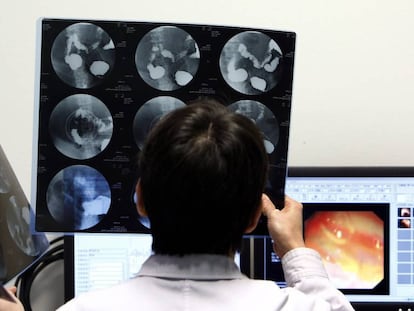Bone marrow from a million: The living legacy of Pablo Ráez
Before dying from leukemia, Spanish athlete launched a massive awareness campaign to seek donors
Pablo Ráez died at the end of February when his leukemia returned after a period of remission. The 20-year-old athlete from Marbella was known for his #retounmillón campaign on social networks, which he launched in September 2016 with the aim of encouraging more people to become bone marrow donors.
When his treatment began in October 2015 at the Carlos Haya Regional University Hospital in Malaga, he began a daily blog, describing the ins and outs of being a leukemia patient. A year later, he began his campaign on social networks. His target was one million donors. “I want to raise awareness, I want to be of use, I want to make people feel better… And it’s possible with your help,” he explained at the time.
I want to raise awareness, I want to be of use, I want to make people feel better… And it’s possible with your help
When Ráez began #retounmillón, he had almost 225,000 followers on Facebook and more than 330,000 on Instagram. Five months later, each of his social network accounts had an additional 100,000 people. And his followers took heed, particularly in Malaga province where bone marrow donors shot up by 1,400% in the last four months of 2016. According to the Health Ministry and the National Organization of Transplants, there were 230,000 bone marrow donors in Spain before Ráez went into action out of a global count of 28 million.
In his blogs, Ráez focused on the importance of such donations. “There is a lot of information available on Google on how to do it,” he wrote in an Instagram post, “and I’m going to keep saying it – not just for Pablo Ráez but for the thousands of children who need a donor, because there are thousands with the disease and because you yourself could need that help at any time.”
Ráez campaigned with enthusiasm and optimism, striking poses with his muscles flexed, which became a sort of logo. As his Facebook and Instagram posts reflect, he loved sport and had an amazingly positive attitude to life. In one of his last posts on Instagram, he wrote, “I don't know what will become of me, but then I have never known. What I do know is that I am finishing one fight to start another, but I will not give up. I am Pablo Ráez Martínez and I’m not a quitter.”
The fact that it is young people who are the most sought-after donors makes Pablo Ráez’s campaign even more significant, as the Carreras Foundation explained on its website. Via social networks, Ráez was able to reach out to a generation not reached by TV and media coverage. According to Ráez’s Facebook page in September 2016, the urgency for donors “was not getting through to the most important audience, namely young people between 18 and 40.”
In the same post, Ráez pointed out: “This age group is more active on social networks and it's important to reach more of them. This is why I am asking those of you who are already aware to spread the message. It's very important to create this chain in which, through luck or misfortune, I am the main link.”
Raising the number of donors is fundamental if leukemia patients are going to have a better chance at recovery
Raising the number of donors is fundamental if leukemia patients are going to have a better chance at recovery. Unlike blood, which has a higher ratio of compatibility, bone marrow is hard to share. According to the Carreras Foundation, “a fundamental aspect of the immune system is the genetic information contained in the cells that we call the HLA system (Human leukocyte antigen). A higher level of donor-recipient HLA compatibility is needed so that the cells from the healthy donor repopulate the patient’s organism without being rejected, making the patient’s sick cells disappear.”
Pablo Ráez is not the only leukemia patient to take to the social networks. In November Verne reported the story of Estíbaliz, whose boyfriend Daniel posted a letter on Facebook encouraging people to donate bone marrow. “For every 4,000 donors, only one is compatible. That’s why I need you to become donors, the more of you, the better. A while ago now, I promised him [Estíbaliz] that we would grow old together and I need you to help me keep this promise.”
English version by Heather Galloway.
How do I donate?
Various members of the Verne editorial team have signed up to become donors. It’s a simple process – you just have to ask for an appointment at the donor center nearest to you, go along for a blood test and wait for them to call. For further information, consult the Carreras Foundation web page. As Daniel explained in his letter – that went viral – “What is just a pin prick for you, could mean life for someone else.”
Tu suscripción se está usando en otro dispositivo
¿Quieres añadir otro usuario a tu suscripción?
Si continúas leyendo en este dispositivo, no se podrá leer en el otro.
FlechaTu suscripción se está usando en otro dispositivo y solo puedes acceder a EL PAÍS desde un dispositivo a la vez.
Si quieres compartir tu cuenta, cambia tu suscripción a la modalidad Premium, así podrás añadir otro usuario. Cada uno accederá con su propia cuenta de email, lo que os permitirá personalizar vuestra experiencia en EL PAÍS.
¿Tienes una suscripción de empresa? Accede aquí para contratar más cuentas.
En el caso de no saber quién está usando tu cuenta, te recomendamos cambiar tu contraseña aquí.
Si decides continuar compartiendo tu cuenta, este mensaje se mostrará en tu dispositivo y en el de la otra persona que está usando tu cuenta de forma indefinida, afectando a tu experiencia de lectura. Puedes consultar aquí los términos y condiciones de la suscripción digital.











































